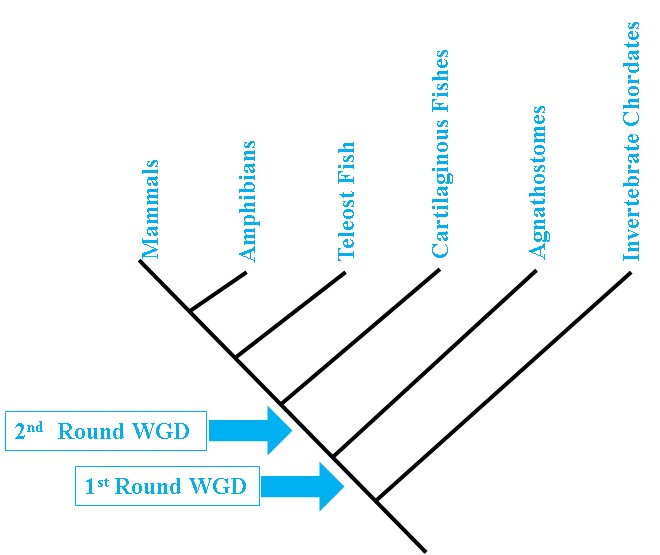Whole Genome Duplications during Vertebrate History (2R)
To explain the genetic basis of major transitions in organismal evolution, Susumu Ohno (1970, 1973) proposed that two rounds of whole-genome duplication (2R hypothesis) occurred during the early evolution of the vertebrate lineage. Recent large-scale comparative genomic studies now place the first whole-genome duplication (WGD) at the base of vertebrates and the second at the base of jawed vertebrates (gnathostomes), supported by synteny and macrosynteny analyses (Simakov et al., 2020; Yu et al., 2024). Ohno’s idea was based solely on genome size differences, chromosomal topologies, and recent tetraploidization events in some fish and amphibians. Over the past decade, the 2R hypothesis has gained extensive support, particularly with the availability of high-resolution genome assemblies across chordates (Figure 1).
Proponents presented several lines of evidence in favor of entire genome duplication hypothesis in the early vertebrates. First, compared to model invertebrate genomes (fruit fly, nematode, sea squirt and amphioxus) the typical vertebrate genome possess more genes (Sidow, 1996). Second, the existence of paralogons in the human genome (Dehal and Boore, 2005; Lundin et al., 2003). Third, the conservation of gene synteny throughout vertebrates and their invertebrate ancestors and the spread of these anciently conserved syntenic fragments among multiple vertebrate chromosomes (vertebrate paralogons)(Hufton et al., 2008; Putnam et al., 2008). Fourth, the refinement of extensive gene duplication events early in vertebrate history through molecular-clock based approaches (absolute dating) (Panopoulou et al., 2003; Vandepoele et al., 2004). Fifth, the extrapolation of genome evolution scenarios in plant and yeast to genome evolution events in vertebrates (Bowers et al., 2003; Kellis et al., 2004; Panopoulou and Poustka, 2005). A further piece of evidence in favor of two rounds of whole genome duplication hypothesis emerges from the observation that protostome invertebrates (fruit fly) and deuterostome cephalochordate amphioxus possess single HOX cluster whereas the vertebrates have four or more clusters (Amores et al., 2004; Garcia-Fernàndez and Holland, 1994; Pollard and Holland, 2000).
Opponents of the 2R hypothesis argued that the current data is not compelling evidence of polyploidization and increase in the number of paralogous genes in vertebrates occurred as a result of small scale gene duplication events involving single genes and chromosomal segments, scattered at different times during the history of life (Abbasi and Grzeschik, 2007; Cotton and Page, 2006; Friedman and Hughes, 2004; Hughes, 1999; Hughes and Friedman, 2003).

Figure 1: The first Whole Genome Duplication (WGD) event occurred at the base of vertebrates, with a second WGD event occurring at the base of gnathostomes (jawed vertebrates).
Useful references: